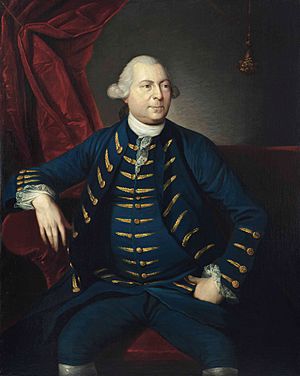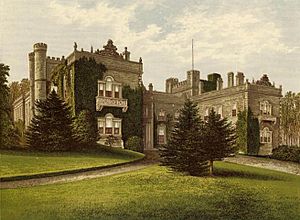Sir Lawrence Dundas, 1st Baronet facts for kids
Sir Lawrence Dundas, 1st Baronet (born October 22, 1712 – died September 21, 1781) was a very successful Scottish businessman and politician. He made a huge fortune and owned many important properties.
Early Life and Business Success
Sir Lawrence Dundas was the son of Thomas Dundas and Bethia Baillie. He first became rich by working as a Commissary General. This meant he supplied goods and food to the British Army during big conflicts like the Jacobite rising of 1745 and the Seven Years' War.
After making his first fortune, Sir Lawrence expanded his business interests. He got involved in banking and property development. For example, he helped develop the town of Grangemouth in 1777. He was also a major supporter of the Forth and Clyde Canal, a very important waterway that even ran through his own land near Falkirk. When he died, he left his son a huge inheritance worth £900,000, which was an enormous sum of money back then!
Homes and Estates
Sir Lawrence Dundas owned several grand homes and estates. In 1763, he bought the Aske Estate in North Yorkshire for £45,000. He then hired a famous architect named John Carr to make the house bigger and more stylish.

He also acquired land in Edinburgh's New Town in 1768. Here, he built his own impressive mansion, which is now known as Dundas House. This beautiful building was designed by Sir William Chambers. Later, in 1825, it became the main office for the Royal Bank of Scotland. You can even see parts of its design on the banknotes issued by the Royal Bank today!
Sir Lawrence also purchased Moor Park, a large house near London. He filled his homes with amazing art and furniture. He ordered special tapestries from France and had famous furniture makers like Thomas Chippendale create pieces for his houses. Even the famous landscape designer Capability Brown worked on the gardens at his Aske estate.
Politics and Family
Because the Aske estate included the small voting area of Richmond, Sir Lawrence was able to choose who would represent that area in Parliament. This showed how much influence he had.
Sir Lawrence married Margaret Bruce, and they had one son named Thomas Dundas.
Art Collector
Sir Lawrence Dundas was a passionate collector of art. He owned many valuable paintings by famous artists like Cuyp, Murillo, Raphael, and Rubens. After he passed away, many of his paintings were sold in a large auction.
Legacy
Sir Lawrence Dundas died in 1781. He was buried in the Dundas Mausoleum at Falkirk Old Parish Church in Scotland. His wife Margaret and son Thomas were later buried there with him.




